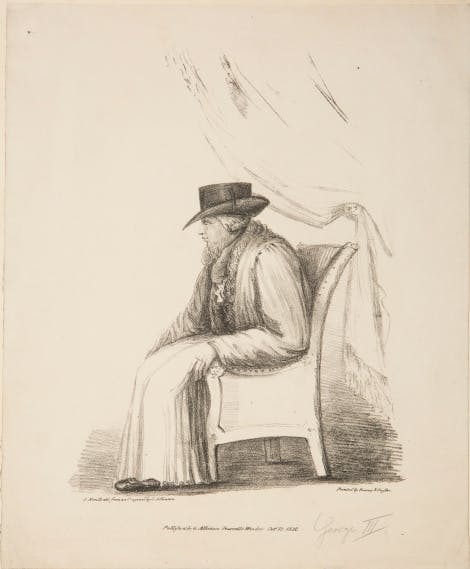The King's 'Malady': George III's Mental Illness Explored
Date: 22 March 2024
Author: Polly Putnam
George III had four prolonged periods of illness during his reign. Despite his achievements, he is perhaps most commonly referred to as ‘The Mad King’ – an unhelpful phrase that undermines the extent of his deeply traumatic ailments, and ignores his physical symptoms.
Here, Kew Palace curator Polly Putnam explores what we know of George’s mental and physical illness, the misconceptions under which his doctors treated him, and his brutal but ineffective treatment at Kew.
WHAT DO WE KNOW ABOUT GEORGE III’S SYMPTOMS?
While George III’s first period of illness in 1765 is largely undocumented, we know much more about his later episodes in 1788-89, 1801, and 1804. His final bout occurred in November 1810 after the death of his beloved daughter, Princess Amelia. He never recovered from this final illness, and died in isolation at Windsor Castle 10 years later.
The King experienced both physical and mental symptoms, including fever, frequent vomiting, and swelling of the legs and feet. The King also complained of aches and pains in his stomach, head and joints, which were so painful that he was unable to walk without a stick.

Image: George III, Queen Charlotte and their six eldest children. © Royal Collection Trust / Her Majesty Queen Elizabeth II
His daughter Princess Elizabeth described a rash which was ‘very red and in great weals, as if it had been scourged by cords’. His doctors mentioned a yellowing of the eyes, dark urine and a series of violent spasms.
The most alarming effect of the King’s illness was his periods of mania. At their mildest George experienced a ‘a desire of talking that he was unable to control’. Often, he would talk for hours until he was hoarse and foaming at the mouth.
Despite his kind nature, his illness caused the King to exhibit inappropriate and wild behaviour. He was sometimes violent towards his staff and doctors, and on one occasion he was violent towards Queen Charlotte.
The moment in which the doctors decided that George III needed prolonged treatments, was a dreadful meal with the Prince of Wales, during which the King berated him in front of Queen Charlotte and the Princesses. The evening ended with George III picking his son up and throwing him on the floor.

Image: Kew Palace, where George III was sent for treatment in the neighbouring White House. © Historic Royal Palaces
The King's Brutal Treatment at Kew Palace
George III was transferred for treatment at the White House, next to what is now known as Kew Palace, in 1788. George Baker, the King’s most senior physician wrote that a ‘change of place and objects is likely to facilitate his recovery’.
Baker was supported by Sir Lucas Pepys, Dr Henry Revell Reynolds Dr Richard and Dr Anthony Addington. He was given various emetics to make him vomit, and was blistered, a process by which caustic powder was applied to his legs until they formed blisters.
The King was also subjected to cupping, where heated glass cups were applied to his body to create suction on the skin. None of these treatments seemed to work.
Since his Majesty has been at Kew the unfavourable symptoms of his disorder have increased rather than diminished.
Robert Fulke Greville, George III’s Equerry
The King’s language became coarser and crueller. He was more melancholy and his behaviour was more erratic. On one occasion he demanded that he be wheeled around his rooms like a child; on another, he stole the page’s wigs and burned them in a fire.
The doctors could not cope and began to quarrel amongst themselves. In desperation, Dr Francis Willis and his sons were brought in to treat the King on 5 December.
THE ‘MORAL METHOD’
Willis and his sons’ treatment, known as the ‘Moral Method’, involved enacting control over the King through stern words and a system of punishment and reward. It was designed to break the King’s spirit and to turn his behaviour from mania into what they saw as compliance.
The King was often confined in a strait waistcoat or bound to his bed. George bitterly referred to one piece of binding equipment – a chair with a strait waistcoat attached – as his ‘throne’. In contrast, the King could be rewarded for ‘good behaviour’ with access to his library or a visit from his family.
By February the King’s condition seemed to improve and on 26 February an official report stated, ‘His Majesty appears to have an entire cessation of his illness’.
CAN WE EVER DIAGNOSE GEORGE III?
George III would return to Kew for treatment twice more, in 1801 and 1804 – coerced into staying in the red brick building now known as Kew Palace, since the White House was falling into disrepair.
It is almost impossible to give a cause for or diagnose the King’s illness. Accounts differ wildly and can be interpreted in many ways. These inconsistencies have led historians to ‘diagnose’ the King with many different illnesses and conditions, including arsenic poisoning, porphyria and most recently bi-polar disorder.

Image: Print of George III during his last period of illness. © Historic Royal Palaces
Studying George III’s illness is made more complicated by the political situation surrounding the King’s treatment. For example, the Prince of Wales installed his own doctor in the King’s household.
If George was deemed incapacitated and unfit to rule, the Prince of Wales could make himself regent and effectively run the country in his father’s place; the Prince’s doctor was tasked with writing pessimistic reports of the King’s illness to increase the likelihood that the Prince could take over as regent.
We can never really know what caused George III’s illness, but we do know that the King suffered greatly, both physically and mentally.
His cruel treatment at the hands of his doctors was painful, humiliating and frightening. During these periods, Queen Charlotte and the couple’s daughters endured agonising hours in their rooms at Kew, anxiously waiting for news. The Prince of Wales’ attempts to use his father’s illness to gain power caused his parents even more strain.
After being moved to permanent seclusion in Windsor in 1810, George would hold imaginary conversations with his dead children and cry for hours.
Much more than a simple story of ‘The Mad King’, George’s periods of mental and physical illness were as complex as the man himself – and had a huge impact on him, his family, and the nation.
Polly Putnam
Curator (Collections)
Historic Royal Palaces
More from our blog

Royal Wetnurses: the 'Foster Mothers' of the Georgian Nursery
24 March 2022
Ahead of Mother's Day, we share the lesser-known histories of the women employed as wetnurses in the Royal Nursery. Taking on the role of 'foster mother' to young princes and princesses, they often developed a close personal bond with the royal family and received mementos that were passed down in families for generations.

The explosive history of the pagoda during World War II
06 June 2023
One of the most surprising periods in the history of the Great Pagoda is its use as a secret testing site during World War II. Curator Polly Putnam picks up the tale of this fascinating discovery.

A tour of Kew's Kitchen Garden
10 September 2019
Like Kew Palace and the Royal Kitchens, the Kitchen Garden is open seasonally to visitors, from April to October. But work in the garden continues all year round. Let's take a tour...
